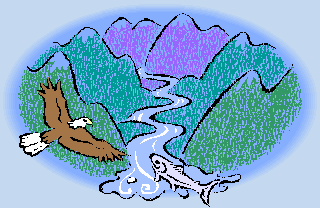Water News for August 2011
While you were focused on the hurricane and
surviving the hot, hot summer,
a lot of important things happened in the world of water. Read on to learn all about it.
Like lemmings rushing to jump off of a cliff,
Americans are now banning clotheslines.
Australian researchers use bacteria to
clean up polluted groundwater, showing that "bacteria
effectively breathe these pollutants the way we breathe oxygen."
Dow Chemical agreed to pay $2.5
million to settle environmental damage claims in Michigan.
Bad-smelling water in Brentwood, TN
water supply has been attributed to blue-green algae.
Contrary to the drilling industry
claim that hydraulic fracturing has never contaminated groundwater,
the Environmental Protection Agency concluded in a 1987 study that
“fracking” of a natural gas well in West Virginia contaminated
an underground drinking water source. That all-but-forgotten
report to Congress, uncovered by Environmental Working Group and
Earthjustice, revealed that fracturing gel from a shale gas well more
than 4,000 feet deep had contaminated well water.
Faced with prolonged drought and 113
degree temperatures, Tulsa is having to ration water for the first
time in 30 years.
The Santa Clarita water district is
enforcing its ban on illegal water softeners.
The Arkansas Oil and Gas Commission
placed a ban on fracking wastewater wells in central Arkansas.
A
moratorium on well activity had been in place for months as
geologists investigated a possible link between fracking activity and
the outbreak of more than 1,200 earthquakes that measured lower than
4.7 in magnitude.
41% of American teenagers now suffer
from dental fluorosis.
The population of the small Alabama
town of Harpersville is enjoying improved water quality, with less
limescale corroding pipework and water-fed equipment, following the
installation of the
Scalewatcher computerized, electronic water conditioner.
The city of Redding, Calif., is
being fined for a chlorine spill from the Clear Creek sewage
treatment plant into the Sacramento River
Research sponsored by the American
Associations for Dental Research has found "no significant association between bone fluoride levels and osteosarcoma
(a rare bone cancer) risk
in a case-control study based
on controls with other tumor diagnoses."
Government's
appointed advisory panel on fracking has been stacked with “experts”
with financial ties to the gas industry making impartiality unlikely.
Towns
in Louisiana are facing critical water shortages. The
state conservation office could be days away from declaring a
groundwater emergency in parts of south Caddo Parish, forcing
curtailment of water not deemed necessary for human needs.
Citizens of Philomath,
Oregon voted to end fluoridation of their water supply, and
fluoridation was rejected by the city council in Spring Hill,
Tennessee.
The town of Robert Lee, TX is in
serious danger of running out of water. The
prospect of no water is a cruel irony for Robert Lee, which was
proclaimed the county seat in 1891 because its water supply was so
plentiful. The town's water source, Lake E.V. Spence, normally covers
more than 22 sq. miles and made Robert Lee a popular boating getaway
where reckless kids dived down from the tall, surrounding bluffs.
Today, jumping would be a perilous fall onto a shoreline of rocks,
and island-like sand dunes widen by the day. (Robert Lee still trucks in 6300 gallons per day to water the
football field.)
Full story.
Tulsa will begin treating its water
with chloramine.
"Brain-eating amoebas"
contracted during swimming were blamed in three deaths this summer.
Batteries that run on bacteria power
generated from wastewater are under development.
The plan
to pipe groundwater across Nevada could
cost billions more than expected.
The drought in Texas is the worst in
the state's history.
 |
| A series of "fun runs" are
taking place in the Philippines to aid 16,000,000 Filipinos who do
not have access to clean drinking water. |
Two Reebok companies will pay a
total of $40,000 to settle claims they failed to do groundwater
testing at a property where hockey equipment was manufactured.
Lake
Conroe (TX) was required to release 50 million gallons of water to
keep Houston's wastewater system afloat.
The EPA
is finally working on a regulatory standard for perchlorate.
The
National Ground Water Association has prepared a press release to
advise well owners of what to do if their well is flooded.
War-torn
Libya is suffering a massive water crisis.
The reasons are unclear.
 |
Did you ever wonder . . . |
What Kind of Water Makes the Best Tasting Coffee?
By Hardly Waite,
Pure Water Gazette Senior Editor
What kind of water makes the best tasting coffee?
Distilled? Softened?
Reverse Osmosis?
Filtered? Spring water? Rain
water?
We did some research and decided to reprint a clip from an
interesting piece on the subject from TheCoffeeBrewers website at http://www.thecoffeebrewers.com/whisbewaforb.html.
The article below states one opinion.There are others.
The short version of this
article is that minerals are necessary to bring out the flavor in
coffee but not in expresso.
Therefore, un-softened water (what they
mean is non-distilled or non-RO water, since softening is really a
different issue) is better for coffee and distilled water (or RO
water) would be better for expresso.
This, as I said, is one
opinion, and a simple web search will get you many opinions, some of
which go much deeper into the matter than you probably want to go,
specifying the dissolved solids count (one source insists that 150 to
200 ppm is ideal), pH (neutral often preferred, but hard to maintain),
alkalinity,
and even the Langlier Index.
One sensible suggestion would be that removing the
chlorine or chloramines used to disinfect the water certainly won't
hurt the taste, so carbon filtration would be an obvious plus for
all coffee water.
Carbon does not affect the mineral content of the
water.
Here's what TheCoffeeBrewers has to say:
What is the Best Water for Brewing Coffee or Espresso?
Did you ever notice how salt will "bring out"
the flavor in food (which is why professionally prepared restaurant
food tends to be salty)? On the other hand, have you noticed how salt
(and other minerals; particularly calcium) will buildup on shower
walls and plumbing fixtures?
When you prepare coffee or espresso, you need to be
aware of the mineral content in the water that you are using. Since
the preparation of (American) coffee and espresso are predicated on
very different extraction techniques, the "best" water is
different for coffee than it is for espresso.
To review (or in case you weren't aware), the flavor
in coffee is mostly contained within the oils within the beans.
Brewing coffee or espresso is a matter of extracting these flavors
from the beans (the coffee grounds) so that they permeate the water.
The preparation of plain coffee is a steeping
process, almost exactly like tea. The coffee grounds (coarse grounds
work better for plain coffee) are mixed with near-boiling water. The
heat and minerals in the water work together to extract the flavor
from the coffee. After a short steeping period, the grounds are
strained out of the mixture (via a filter), leaving the beverage
known as "coffee."
To get a flavorful coffee, there must be mineral
content in the water. If the water is distilled, or if it has been
softened too much (softening is the process of removing minerals),
the extraction will be weak, and the beverage will be relatively
flavorless - as food can be if no salt is used.
On the other hand, espresso extraction is a very
different process that does not require minerals, and in which
near-boiling temperatures are actually detrimental. For espresso, a
more finely ground coffee is first compressed into a "puck"
through which water will not pass easily. Ideally, immediately prior
to extraction, the puck is pre-wet (both to begin dissolution, and to
make the density within the puck uniform, so that the extraction will
also be uniform).
Then, hot water (195-200 degrees Fahrenheit) is
rapidly pushed through the puck under pressure. Ideally, the pressure
should be in the 10-15 bar range (1 bar = 14.6 pounds per square
inch), and the extraction time should be 20-25 seconds, maximum. (A
longer extraction will result in a bitter and burnt flavor.)
In this kind of extraction, since the water is forced
through the puck very rapidly (each water molecule moves through the
puck in a fraction of a second), the water is not in contact with the
coffee long enough for the minerals (in the water) to play much of a
role in the extraction.
Also, for those of you who have taken some Chemistry,
you may remember the ideal gas law: PV = nRT. While we are dealing
with fluids in this case, note that Pressure (P) and Temperature (T)
are on opposite sides of the equation. Since we do espresso
extraction under (relatively) high pressure, we do not need a boiling
temperature.
In fact, water that is too hot will over-extract the
espresso, resulting in a bitter flavor. The reason that moka pots
(stovetop brewers) tend to make bitter brews is because the
temperature is steam temperature, and the pressure is too low, so the
extraction will tend to be too long.
Therefore, minerals in water will not enhance the
flavor of espresso. On the other hand, minerals will build up on the
inner surfaces (the boiler, the internal tubes, and the portafilter)
of the espresso machine. This buildup will alter the pressure within
the machine, and it will corrode the internals of the machine.
The gradually increasing pressure change will
adversely cause the uniformity of the extraction (hence, the flavor)
of the espresso to change over time. The added pressure will also
cause the internal pumps and gaskets to wear out quickly. By far, the
one thing that is most detrimental to an espresso machine is mineral
buildup.
This is why it is so important to do periodic
cleaning of an espresso machine (as per the manufacturer's
recommendations) with a de-scaling agent. In addition, it is best if
you use distilled water, or at least a water softener. For commercial
machines (which will see heavy use), an in-line water softener is
essential.
While drip coffee-makers will also get mineral
buildup, and should be de-scaled occasionally, this is just so that
the water will flow (at all) through the machine. Since no pressure
in involved in the brewing of drip coffee, mineral buildup will not
damage a drip coffee-maker the way that it will destroy an espresso
machine. If you have an expensive espresso machine, it is imperative
to keep it clean.
For plain coffee, a minimum mineral content of
150-200 parts per million is essential to a good extraction. Water
softer than this will result in weak and flavorless coffee. For
espresso, you should use distilled water. If the espresso machine is
connected to the building plumbing, an in-line water softener (to
remove the minerals) is essential.
TheCoffeeBrewers
And what about tea?
The "English Tea" website says:
The Best Water for Making Tea
A cup of tea comprises of over 99% water so it is hardly surprising that the quality of the water used is critical to the flavour of the tea. Fine teas are especially sensitive to the type of water used.
The best water for making a cup of tea is low in mineral content, free of contamination and additives and high in oxygen content. The presence of these factors can all influence the taste of tea – so a good test is to try the water before you use it to make your brew. It the water tastes good, then it's safe to use. If the water is tainted in any way, it's best not to use it.
After that, the site says, the way you boil the tea is of extreme importance:
Re-using water in your kettle that has already been pre-boiled is not a good idea if you want to make a perfect cup of tea. Most experts agree that you should never re-boil previously boiled water, or boil the water for too long. As water boils, oxygen is driven out and the more it boils, the less oxygen stays in the water. Water that has already been boiled, like the water that usually sits in your kettle, contains much less oxygen than fresh water. Tea made with water that has depleted oxygen content loses its crisp, fresh taste.
Whole House Water Filters: High Flow Rates at a Low Price
The slower water flows through a water filter the better it works. At lower flow rates, you get better performance, less pressure drop, and in most cases longer filter life.
An easy way to cut the flow rate in half is to install two filters side by side, splitting the water stream and allowing each filter to handle only half as much water.
The advantages include in most cases lower cost as well as improved performance. Splitting the work load between two standard sized filters as opposed to using a single larger specialty filter usually pays off in both initial cost and operating expense, since standard sized items cost lest than oversized systems.
Below are a couple of examples taken from our customers' installations. In both cases, the use of multiple standard 4.5" X 20" (20-inch "Big Blue") filters cost considerably less than either our 4-cartridge stainless steel units or our "Big Bubba" style high flow filter. And the same is true with replacements. Two standard 4.5" X 20" MatriKX carbon blocks cost
a third as much as a single Big Bubba carbon replacement.
A Car Wash Application
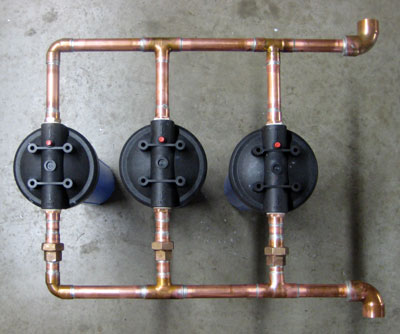 |
The Three-Filter Manifold was build by Denton plumber Larry Sawyer for a New Jersey carwash. It divides the water stream into thirds to provide sediment filtration of a 60 gallon-per-minute water demand. |
A Classy Residential Application
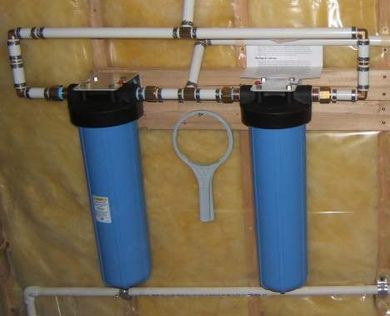 |
Above is a double carbon filter installed in a home in Missoula, Montana by Roger's Plumbing Service.
The whole house filter installation splits the flow of water so that each of the carbon block filters handles only half the water at a reduced flow rate.
Below, a full view of the same installation showing test tap and bypasses. This neat installation was done with PEX pipe. |
|
Tiger Tom on Ultraviolet Water Treatment
Regular Occasional columnist and numerical wizard B. B. Sharper is vacationing in Oregon this month. She writes:
August 28 temperature in Coos Bay, OR -- 66.
August 28 temperature in Denton, TX -- 107.
In B. Bea's absence, we're dusting off an early 1990s piece, published in a paper Pure Water Gazette issue on the subject of the rights of bacteria.
Satirist Tiger Tom was a regular
contributor to the old paper Pure Water Gazette and some of his pieces are archived in the
current online version.
His work has not until now adorned the Occasional's pages
because he so seldom writes about water. He most frequently focuses on the pressing social and philosophical issues of our time. His current project, for example, is a detailed examination of the imminent push for Same Person Marriage. I'll let him explain:
As people get used to the idea of same sex marriage, the next logical step in our evolution toward a saner social order is same person marriage. Allowing a single person to marry him- or herself would in one simple act address many social problems and injustices, including the unfair discrimination against singles in our tax codes, the senseless stigma placed on masturbation, overpopulation, parenting outside wedlock, the need for life insurance, and much more.
In light of the above, I'm sure you won't expect Tiger Tom's treatise on ultraviolet water treatment to be the usual explanation of UV doses, wavelengths, and megajoules per square centimeter. I'm cleaning up Tiger Tom's original just a bit to put it more in line with the advances made in political correctness in the two decades since the original writing.-- Hardly Waite.
Some Ethical Ramifications of Water Purification
A Scholarly Review of Existing Water Sanitation Methodology
by
The Chinese . . . spread their sewage on the ground and get worms in their guts from drinking contaminated water and eating filthy food. We in the Western world are more civilized--we take our sewage and dump it into our rivers. We then drain it into our water supply, strain it and inject chlorine into it. We don't get worms in our guts, but we sure do get something else.--Dr. Joseph M. Price, M.D.
Some people
get steamy eyed when they talk about the misery chlorine puts on birds and beasts and plants and people, but I haven't seen anyone shedding tears over bleach's biggest victims. I mean the tiny water-dwellers that chlorine fries by the trillions of trillions. Having had the shits a few times myself, I'm no big amigo of bacteria. But let's be fair. The little gut-dwellers are only doing their job. And a nasty job it is. I say they deserve a better fate than chemical warfare.
Being kind to little water creatures isn't easy. Sometimes it's them or us. When people started bleaching the water around 1900, ailments like cholera and typhoid fell quickly in the disease ratings. Doctors tried to take the credit, but it was really Clorox that did the trick. Bleach is a poison, and in water it mixes with other ingredients and makes approximately one bezillion new poisons, which scientists call THMs. These are by-products of water treatment. THMs cause cancer. Now we have a lot less cholera and a lot more cancer. And they keep putting in more bleach.
Some things aren't killed by bleach. Probably you've heard of Cryptosporidium and Giardia lamblia. Crypto gave half of Milwaukee a very sick belly not long ago. A lot of people died. Bleach doesn't even stun these fellows. But they are giants, so it's easy to trap them in a filter, which is really just a tiny fishing net. Cryptos are so big that a fairly tight fishing net nabs them. That's why I, Tiger Tom, say that it is easier for a rich man riding a camel to pass through the eye of a needle than for a Crypto to pass through a ceramic filter cartridge.
The public plan for bacteria has always been to fry them in bleach. There are other ways, though most aren't any kinder. Iodine poisons them, and ozone fries them crisper than chlorine. Ceramic filters are 99.99% effective at snaring them. Even tight carbon filters strain them out, but carbon filter makers don't brag in their ads about bacteria removal because it's risky. Someone gets sick, calls his lawyer, and you're screwed.
The kindest way to make water safe, and the way that I, Tiger Tom, recommend to my friends and closest relatives, is ultraviolet (UV) light. That's how sunlight purifies water in a mountain brook. It leaves no chemicals behind. UV purifiers work by passing water close to a long ultraviolet lamp, which looks like a fluorescent bulb, inside a quartz tube. After a trip past the magic lamp, the nastiest germs are as polite as shoe salesmen.
The interesting part is that the experts know that UV light stops bacteria cold, but they really aren't sure how.
They usually say something like this, which I, Tiger Tom, copied from a Water Technology article I read while I was waiting for a bus.
"UV alters the genetic information of microbes, thereby inhibiting the metabolic processes including their ability to replicate." The writer was trying to say that the light screws up their sex life. They stop reproducing. In water treatment, if a microbe can't reproduce it is legally dead. If human people followed this logic, they could collect on their insurance if they had a vasectomy. The logic with bacteria is, if they can't reproduce, they can't hurt you.
This explanation of UV light makes UV treatment sound like a spay/ neuter program for bacteria. I, Tiger Tom, do not buy it. I have my own theory of how UV works.
I say it's related to all the many miraculous events that have to do with light. Scientists invented the neutering story because they aren't allowed to talk about miracles. Science is a miracle-free religion. Unless they want you to believe some weird yarn like the Big Bang story, which takes a lot more faith than the Virgin of Guadalupe business, they're all against miracles.
Probably you know the story of the big Christian persecutor Saul who got turned into the apostle Paul by a big light. Saul
was on his way to Damascus one day to hassle Christians when, lo, a giant light whammed him. He was blind for a few days; then he was a changed man. I, Tiger Tom, say that this is what happens to bacteria. They aren't neutered; they are converted when they see the light.
Just imagine these darkness-loving little gut-dwellers, floating along happy as bunnies in the friendly blackness of a cool water pipe, doing their thing, feeding on the abundant slime, replicating wildly, when suddenly they come around a bend and it hits them, as bright as a thousand suns, a beam of a zillion Angstrom units. This is clearly a miracle. Never in the annals of Bacteriadom has a light appeared in a water pipe. They fall to their little knees and kowtow wildly. They stop replicating and causing diarrhea and spend the rest of their short lives meditating. If they quit reproducing, it isn't because their DNA is screwed. It's because they've become celibate. St. Paul quit replicating after he saw the light, didn't he?
 |
What a bacterium sees when he rounds a bend inside a UV-treated water pipe. |
The Greatest Water Engineering Feat You Never Heard Of
by Gene Franks
If I told you that a third-world desert nation of only five million people,
with no help from the wealthy West, and in fact during times of harsh economic sanctions from the wealthy West, managed to carry out a decades-long project that brought abundant life-giving water to its cities and its farmers--that this project, in fact, consists of some 1300 wells, most of them 500 meters deep, and that it provides 6.5 million cubic meters of water per day to farms and cities flowing through a network of 1,500 miles of 12-foot diameter pipes that covers an area equal in size to Western Europe--that the pipeline feeds man-made lakes and provides 100,000 gallons of water per person per year for the country's citizens, and that if consumption does not increase, the "fossil water" that supplies the project could last up to 1,000 years--if I told you that, would you assume that the visionary who conceived, financed, and carried out this massive coup of engineering genius was honored and revered as a leader, praised by the media and by governments, honored by humanitarian organizations and recipient of a Nobel Prize?
Well, you would be wrong.
The project described is Libya's Great Man-Made River, and the leader who conceived it and saw it to near completion was Muammar Gaddafii, the punching bag of almost every Western politician since Ronald Reagan.
One of the great mysteries of Libya is
why most of us in the West have scarcely heard of what is called "the
8th wonder of the world" and "perhaps the world's greatest
engineering feat."
I'll leave it to you to puzzle out why.
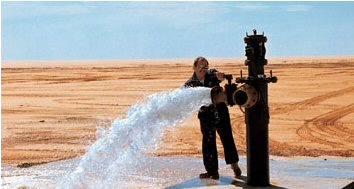 |
Water gushing from one of the 1,116 active drills deep inside the arid desert. The "fossil water" in the picture has been deep beneath the Sahara for a million years. |
The "Great Man-Made
River," a massive engineering project that was financed totally
by
Libyans without Western banks, was originally conceived in the 1950s, has been a work in progress
since the 1960s, and really got rolling in the 1980s.
Although it is incomplete, the parts that have been finished have transformed arid regions of Libya and provide water for its major cities.
The Great Man-Made River draws its water from an ancient sea beneath the Sahara. Here's how an excellent website devoted to the project describes it:
Foremostly, we should say something about the Sahara Desert. In most people's opinion this desert must be a bone-dry area completely depleted of water. Undoubtedly, this part of the world is indeed arid regarding the rainfall (although the driest place in the world is the South American Atacama Desert in Chile). However, the geological surveys in fifties revealed a surprising fact - there lie enormous groundwater reservoirs beneath the surface. This water is locked hundreds of meters deep, beneath vast areas of the eastern parts of Sahara (mostly Libya, Chad, Sudan and Egypt). Geologists call these reservoirs the Nubian Sandstone Aquifer System (geological term "aquifer" means an underground layer saturated with water), which is the world's largest reservoir of fossil water, covering more than 2 million square kilometers (772,000 sq mi) and containing an overwhelming volume of water - estimates lie around 150,000 km3 (36,000 cu mi). That's more than twice the volume of the Caspian Sea! It is also noteworthy that this water originated mostly from the last ice age (therefore, the term "fossil"), and has accumulated in the reservoirs approximately 1 million - 10 000 years ago, when the climate was generally wet, rich in rainfall, and sufficient for maintaining a complex river system. Due to the steep decrease in rainfall since the end of the ice age these reservoirs are not being renewed anymore.
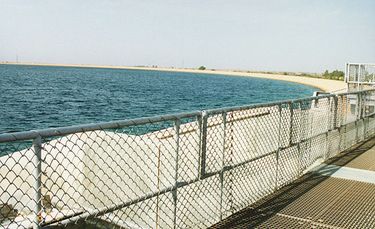 |
One of the Libyan reservoirs fed by the Great Man Made River |
|
